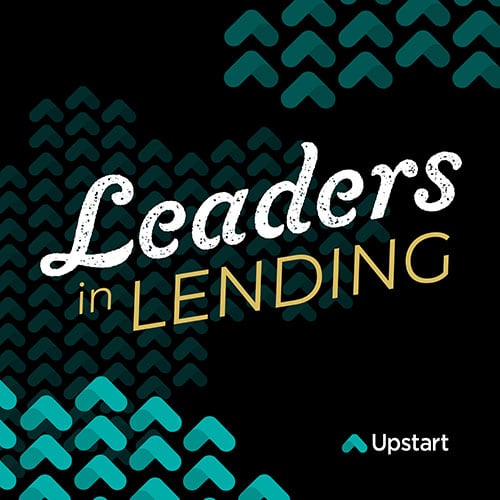Leaders in Lending | Ep. 102
The Upstart Macro Index (UMI)
In this episode, we speak with Paul Gu, Co-Founder and Head of Product at Upstart, about the Upstart Macro Index (UMI) and the insights it can offer to lenders as well as the greater health of the economy and American consumer.


GUEST SPEAKER
Paul Gu
Paul Gu is the Co-Founder and Head of Product at Upstart. While pursuing a degree in Computer Science and Economics at Yale, he began to notice an entire community of people having a hard time getting access to credit, and thought he could do something about it - which lead to him co-founding Upstart over 9 years ago. He has been recognized as one of Peter Thiel’s 20 under 20 Fellows and Silicon Valley Business Journal’s 40 under 40.

ABOUT
Upstart
Our mission is to enable effortless credit based on true risk. Upstart is a leading artificial intelligence (AI) lending platform designed to improve access to affordable credit while reducing the risk and costs of lending for our bank partners. By leveraging Upstart's AI platform, Upstart-powered banks can offer higher approval rates and experience lower loss rates, while simultaneously delivering the exceptional digital-first lending experience their customers demand.
Key Topics Covered
- The concept of the Upstart Macro Index (UMI)
- How the Upstart Macro Index functions
- How to leverage UMI in the context of lending partnerships

“[UMI] does a really good job for us of both explaining how past delinquency patterns have played out and why they've played out that way.”

"I think it's nearly impossible to solve for macro problems by changing the character borrower level characteristics that you underwrite to, because there are no set of characteristics that are inherently recession proof or macro shock proof."

“You're going to get a very good approximation, just from UMI that is built on unsecured personal loans. But, we look at it in the context of our other products, like our auto refi products.”
EPISODE RECAP & SUMMARY
In 2021, loan repayments were at a historic high; by mid-2022, the tables had turned — what happened?
To get to the bottom of this alarming shift, Upstart created the Upstart Macro Index (UMI), a precise, quantitative method for separating the micro and macro effects that should influence underwriting decisions today.
In this episode, we speak with Paul Gu, Co-Founder and Head of Product at Upstart, about the Upstart Macro Index and the insights it can offer to lenders as well as the greater health of the economy and American consumer.
Join us as Jeff and Paul discuss:
- The concept of the Upstart Macro Index (UMI)
- How the Upstart Macro Index functions
- How to leverage UMI in the context of lending partnerships
The concept of the Upstart Macro Index (UMI)
In mid-2021, loan repayments were, on average, consistent and on time, with accelerated repayment rates compared to historical norms. In 2022, repayments told a different story.
“Instead of every type of borrower outperforming, now you have almost every borrower underperforming. The change from mid-2021 to mid-2022 was dramatic.” Gu says, “You could see that in a variety of metrics. However, it wasn't clear how you would precisely tease that out and quantify what had happened in the macro environment.”
An underwriting model’s function is to separate risk and narrow down on particular applicants that are more likely to default than others, answering questions such as:
- What does a near-risk-free borrower look like?
- What does a high-risk borrower look like?
- What is the average population default rate going to look like?
Understanding the jump from mid-2021 to mid-2022 called for a more detailed approach — one that could explain the macro effects of underwriting in a measured and consistent way.
“We separated the micro and macro question,” Gu says, “We asked: ‘How can we precisely measure only the macro component and know whether a period is seeing an increase or decrease, and how much compared to past periods in its average level of default across the population?’ That's what we wanted to know.”
Armed with that data, Gu and his team got to work on what would become the Upstart Macro Index.
How the Upstart Macro Index functions
The UMI, essentially, answers a specific question: If you were consistently making loans to the same group of people across different periods, what would the delta in their delinquency rates be?
“It looks across different days, weeks, months, years — whatever timeframe you want to compare. And the way it does this is by making use of what we call a reference model.” Gu explains.
A reference model removes the challenge of finding identical borrowers each year and gathers information beyond FICO scores for more comprehensive analysis.
“The reference model is doing the work of controlling for the consumer, and then you observe the actual loss rates in real calendar months, compared to what the model would have predicted on this abstracted — hypothetically constant — calendar.” Gu continues.
This function relays how much more or less risky 2022 was, compared to 2021, 2019, 2017, etc. With explanations for why past delinquency patterns played out the way they did, we see a clearer picture of what’s to come.
How to leverage UMI in the context of lending partnerships
How, exactly, do these metrics tie into lending partnerships? There’s a delicate balance when using UMI in this context. It takes careful attention to where the UMF sits during initial analysis and future calculations. The reference point matters.
“Imagine your UMF is 2.0, but the UMI observed is only 1.8. Even though 1.8 is a high number by historical standards, it's 10% lower than the AUMF that you assumed.” Gu says, “That means that your loans were priced as if you were operating in a 2.0 type world, but actually, you've been seeing a 1.8 world, and now you're going to see defaults and delinquencies that are running, on average, 10% lower than you were expecting.”
Taking note of the reference model, and keeping specific circumstances in mind, can make all the difference when leveraging UMI in partnerships and choosing the correct borrowers. Under the umbrella of the Upstart Macro Index, we simplify the process.
Stay tuned for new episodes every week on the Leaders in Lending Podcast.





